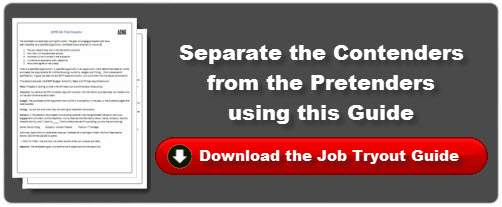A Do-It-Yourself Process to Hire ‘A’ Player Sales Reps
A Do-It-Yourself Process to Hire ‘A’ Player Sales Reps:from Sales Force Effectiveness Blog
Hiring great talent is an inhibitor to delivering revenue growth. It’s not easy finding ‘A’ players. Small businesses (<$50M), in particular, need to nail this or risk revenue disruption. This post is for small business CEOs struggling to hire top sales talent.
One simple way to improve your hiring process is to use a job tryout. Download the Job Tryout Scenario Guide here to help. In it, you'll get:
- A mock job scenario for candidates
- Role play guidance for participants
- A simple scoring tool to assess the candidate
I’m conducting a workshop on SBI’s Topgrading for Sales methodology. The goal is to help CEOs find better sales people. Topgrading for Sales takes the guesswork out of hiring. It teaches you:
- How to interview systematically for A-level talent
- How to coach B-level reps to turn them into A-players
- How to weed out C-players before they do too much damage
So What’s the Fix?
Below are the 5 phases of SBI’s talent management methodology. Inside the phases are 16 modules. This is the roadmap for hiring and developing ‘A’ player sales talent. Today’s post focuses on phases 1-3.
1. Talent Definition
This phase is about defining ‘A’ player sales talent. Begin by calculating your recent cost of sales mis-hires. Why? It is a critical step. You’re likely to find a sales mis-hire costs you 6-7x that person’s compensation. It highlights why investing in the next 4 phases is so important. Hiring fast is very costly. You can learn how to do this on page 16 of Topgrading.This week’s workshop is focused on developing ‘A’ player scorecards for sales talent. This is about defining what ‘great’ looks like for a rep at your company. You can learn how to develop an ‘A’ player scorecard in Appendix A of the book.
2. Talent Acquisition
There are 4 modules for Talent Acquisition:- Search
- Sourcing
- Career History Form
- Phone Screen
Once you source candidates, you’ll need a way to quickly narrow your options. The Career History form is designed to do this. It can be found in Appendix B of Topgrading. Resumes can be deceptive. The CHF forces candidates to be specific about:
- Sales achievements
- Year-over-year earnings
- Managerial references with contact information
- Reasons for leaving/taking specific roles
3. Talent Evaluation
You’re down to a small group. Talent Evaluation focuses on interviewing to the specific competencies required of the sales rep. You can find competency interview examples in Appendix C of the book.Sales reps know how to interview. They can answer many of the questions you ask with ease. The best practice is to put candidates through a controlled scenario tryout. This puts candidates through a real-life scenario from your organization.
It’s the equivalent of an actor doing an audition. A football player on the pre-season roster. A baseball player seeing action during spring training.
Tools for this are not in the book. To see an example of how to do this, download the Job Tryout Scenario Guide.
By conducting job scenario tryouts, you’re moving towards best-in-class hiring practices. Your competitors are rushing to make sales hires. The urge to fill roles quickly will make their cost of mis-hires soar. You’re increasing your chances of hiring ‘A’ player talent by doing this. Take advantage of the resource guide to help you.
You’re on the path to building an ‘A’ player talent management process. Phases 1-3 of SBI’s Talent Management methodology focus on:
- Defining ‘A’ player sales talent for your company
- Acquiring and narrowing down a list of candidates
- Evaluating top candidates through competencies and a scenario-based job tryout
- How to select the best candidate
- How to onboard, develop and retain your top sales talent
Author: Ryan Tognazzini
Follow @RyanTognazzini
Follow Sales Benchmark Index @MakingTheNumber
If you enjoyed this post, never miss one again by subscribing your Email Here and/or subscribing to the RSS.



No comments:
Post a Comment